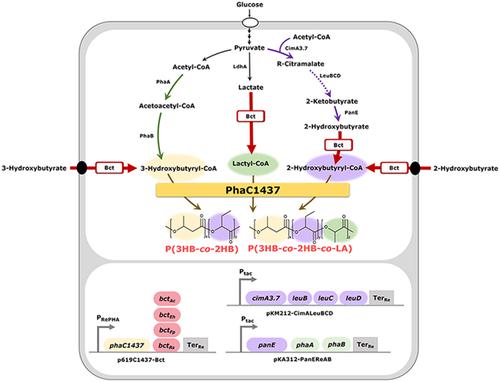当前位置:
X-MOL 学术
›
Biotechnol. J.
›
论文详情
Our official English website, www.x-mol.net, welcomes your
feedback! (Note: you will need to create a separate account there.)
Biosynthesis of 2-Hydroxyacid-Containing Polyhydroxyalkanoates by Employing butyryl-CoA Transferases in Metabolically Engineered Escherichia coli
Biotechnology Journal ( IF 3.2 ) Pub Date : 2017-09-21 , DOI: 10.1002/biot.201700116 Yokimiko David 1 , Jeong Chan Joo 2 , Jung Eun Yang 3 , Young Hoon Oh 2 , Sang Yup Lee 3 , Si Jae Park 1
Biotechnology Journal ( IF 3.2 ) Pub Date : 2017-09-21 , DOI: 10.1002/biot.201700116 Yokimiko David 1 , Jeong Chan Joo 2 , Jung Eun Yang 3 , Young Hoon Oh 2 , Sang Yup Lee 3 , Si Jae Park 1
Affiliation

|
The authors previously reported the production of polyhydroxyalkanoates (PHAs) containing 2-hydroxyacid monomers by expressing evolved Pseudomonas sp. 6-19 PHA synthase and Clostridium propionicum propionyl-CoA transferase in engineered microorganisms. Here, the authors examined four butyryl-CoA transferases from Roseburia sp., Eubacterium hallii, Faecalibacterium prausnitzii, and Anaerostipes caccae as potential CoA-transferases to support synthesis of polymers having 2HA monomer. In vitro activity analyses of the four butyryl-CoA transferases suggested that each butyryl-CoA transferase has different activities towards 2-hydroxybutyrate (2HB), 3-hydroxybutyrate (3HB), and lactate (LA). When Escherichia coli XL1-Blue expressing Pseudomonas sp. 6-19 PhaC1437 along with one butyryl-CoA transferase is cultured in chemically defined MR medium containing 20 g L−1 of glucose, 2 g L−1 of sodium 3-hydroxybutyrate, and various concentrations of sodium 2-hydroxybutyrate, PHAs consisting of 3HB, 2HB, and LA are produced. The monomer composition of PHAs agreed well with the substrate specificities of butyryl-CoA transferases from E. hallii, F. prausnitzii, and A. caccae, but not Roseburia sp. When E. coli XL1-Blue expressing PhaC1437 and E. hallii butyryl-CoA transferase is cultured in MR medium containing 20 g L−1 of glucose and 2 g L−1 of sodium 2-hydroxybutyrate, P(65.7 mol% 2HB-co-34.3 mol% LA) is produced with the highest PHA content of 30 wt%. Butyryl-CoA transferases also supported the production of P(3HB-co-2HB-co-LA) from glucose as the sole carbon source in E. coli XL1-Blue strains when one of these bct genes is expressed with phaC1437, cimA3.7, leuBCD, panE, and phaAB genes. Butyryl-CoA transferases characterized in this study can be used for engineering of microorganisms that produce PHAs containing novel 2-hydroxyacid monomers. Polyhydroxyalkanoates (PHAs) are biodegradable polymers that can be utilized in various fields. In this study, four butyryl-CoA transferases for the synthesis of 2-hydroxyacid containing PHAs in recombinant Escherichia coli strains is examined. Butyryl-CoA transferases examined in this study can be used for the synthesis of 2-hydroxyacid containing PHAs without much reduced cell growth rate of the host strain.
中文翻译:

通过在代谢工程化的大肠杆菌中使用丁酰辅酶A转移酶生物合成含2-羟基的聚羟基链烷酸酯
作者先前报道了通过表达进化的假单胞菌属sp产生含有2-羟基酸单体的聚羟基链烷酸酯(PHAs)。工程微生物中的6-19 PHA合酶和丙酸梭菌丙酰辅酶A转移酶。在这里,作者研究了来自Roseburia sp。,Eubacterium hallii,Faecalibacterium prausnitzii和Anaerostipes caccae的四种丁酰-CoA转移酶。作为潜在的CoA转移酶来支持具有2HA单体的聚合物的合成。四种丁酰-CoA转移酶的体外活性分析表明,每种丁酰-CoA转移酶对2-羟基丁酸酯(2HB),3-羟基丁酸酯(3HB)和乳酸(LA)具有不同的活性。当大肠杆菌XL1-Blue表达假单胞菌sp。将6-19 PhaC1437与一种丁酰CoA转移酶一起在化学成分明确的MR培养基中培养,该培养基包含20 g L -1的葡萄糖,2 g L -1的3-羟基丁酸钠和各种浓度的2-羟基丁酸钠,PHA包括生产了3HB,2HB和LA。PHA的单体组成与来自ABS的丁酰CoA转移酶的底物特异性非常吻合E. hallii,F。prausnitzii和A. caccae,但不是Roseburia sp.。当大肠杆菌表达PhaC1437和XL1-蓝霍氏真杆菌丁酰辅酶A转移酶在含有20克L- MR培养基培养-1葡萄糖和2克L-的-1钠2-羟基丁酸盐的,P(65.7%(摩尔)2HB-共-34.3 mol%LA)的PHA含量最高,为30 wt%。丁酰辅酶A转移酶还支持生产P(3HB的-CO- 2HB -CO- LA)从葡萄糖作为唯一碳源的大肠杆菌,当这些中的一个XL1-蓝菌株BCT基因与表达phaC1437,cimA3.7,leuBCD,panE和phaAB基因。本研究中表征的丁酰辅酶A转移酶可用于工程改造产生含有新型2-羟基酸单体的PHA的微生物。聚羟基链烷酸酯(PHA)是可生物降解的聚合物,可用于各种领域。在这项研究中,检查了四种丁酰辅酶A转移酶,用于在重组大肠杆菌菌株中合成含2-羟酸的PHA 。本研究中检测到的丁酰辅酶A转移酶可用于合成含2-羟酸的PHA,而不会大大降低宿主菌株的细胞生长速率。
更新日期:2017-12-14
中文翻译:

通过在代谢工程化的大肠杆菌中使用丁酰辅酶A转移酶生物合成含2-羟基的聚羟基链烷酸酯
作者先前报道了通过表达进化的假单胞菌属sp产生含有2-羟基酸单体的聚羟基链烷酸酯(PHAs)。工程微生物中的6-19 PHA合酶和丙酸梭菌丙酰辅酶A转移酶。在这里,作者研究了来自Roseburia sp。,Eubacterium hallii,Faecalibacterium prausnitzii和Anaerostipes caccae的四种丁酰-CoA转移酶。作为潜在的CoA转移酶来支持具有2HA单体的聚合物的合成。四种丁酰-CoA转移酶的体外活性分析表明,每种丁酰-CoA转移酶对2-羟基丁酸酯(2HB),3-羟基丁酸酯(3HB)和乳酸(LA)具有不同的活性。当大肠杆菌XL1-Blue表达假单胞菌sp。将6-19 PhaC1437与一种丁酰CoA转移酶一起在化学成分明确的MR培养基中培养,该培养基包含20 g L -1的葡萄糖,2 g L -1的3-羟基丁酸钠和各种浓度的2-羟基丁酸钠,PHA包括生产了3HB,2HB和LA。PHA的单体组成与来自ABS的丁酰CoA转移酶的底物特异性非常吻合E. hallii,F。prausnitzii和A. caccae,但不是Roseburia sp.。当大肠杆菌表达PhaC1437和XL1-蓝霍氏真杆菌丁酰辅酶A转移酶在含有20克L- MR培养基培养-1葡萄糖和2克L-的-1钠2-羟基丁酸盐的,P(65.7%(摩尔)2HB-共-34.3 mol%LA)的PHA含量最高,为30 wt%。丁酰辅酶A转移酶还支持生产P(3HB的-CO- 2HB -CO- LA)从葡萄糖作为唯一碳源的大肠杆菌,当这些中的一个XL1-蓝菌株BCT基因与表达phaC1437,cimA3.7,leuBCD,panE和phaAB基因。本研究中表征的丁酰辅酶A转移酶可用于工程改造产生含有新型2-羟基酸单体的PHA的微生物。聚羟基链烷酸酯(PHA)是可生物降解的聚合物,可用于各种领域。在这项研究中,检查了四种丁酰辅酶A转移酶,用于在重组大肠杆菌菌株中合成含2-羟酸的PHA 。本研究中检测到的丁酰辅酶A转移酶可用于合成含2-羟酸的PHA,而不会大大降低宿主菌株的细胞生长速率。


















































 京公网安备 11010802027423号
京公网安备 11010802027423号